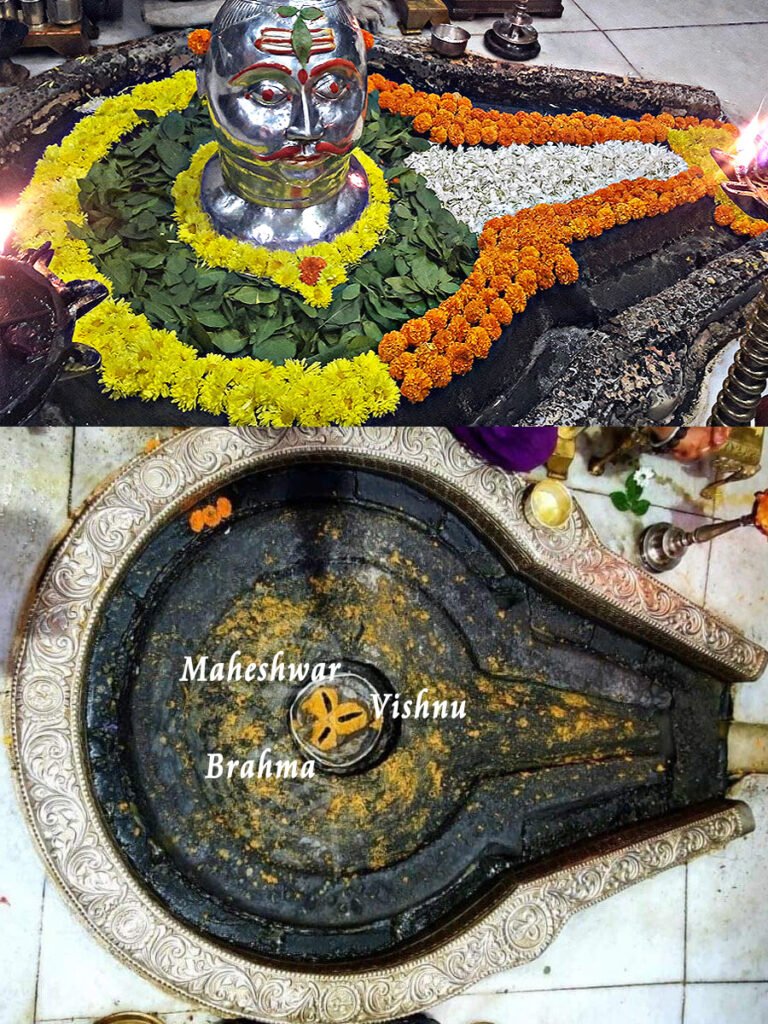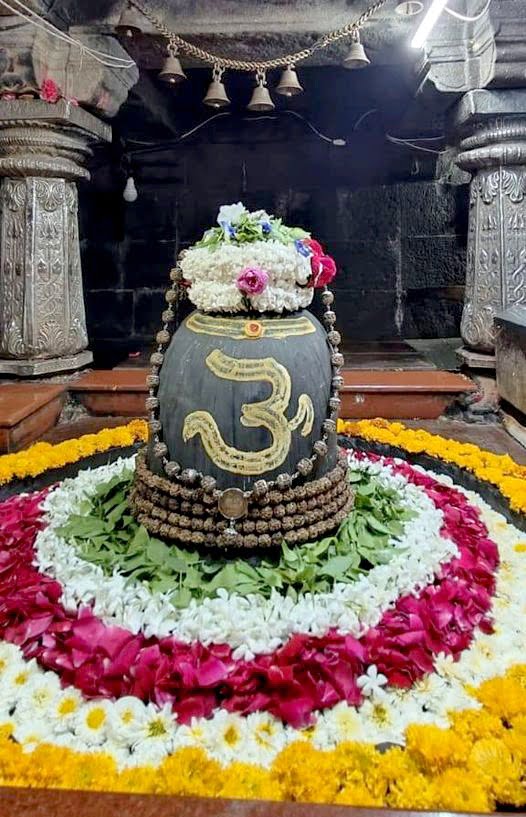Khajuraho’s Kandariya Mahadeva Temple: Lost Wisdom of Spiritual Secrets
Kandariya Mahadeva Temple Khajuraho: Hello folks, today I am going to take you to enchanted journey to a very special location in India, a location where rocks have tales of gods and goddesses, and each carving hums a silent prayer. We’re about to discover the grand Kandariya Mahadeva Temple Khajuraho. Imagine, for a brief instant, a magnificent temple constructed many, many years before, so ancient that your great-great-grandparents were not born when it was constructed!
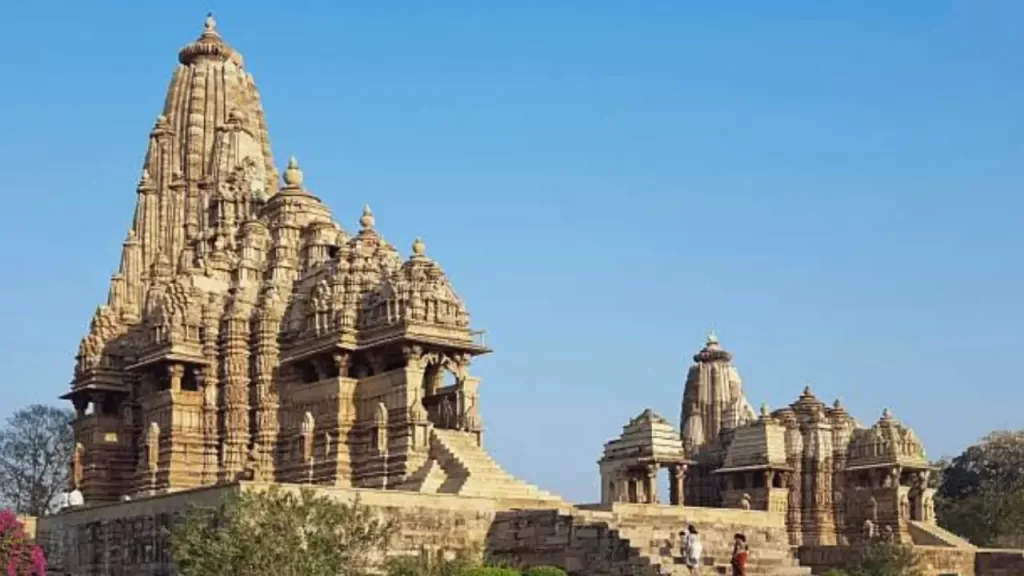
Contents
- 1 The Whispers of Time: Kandariya Mahadeva Temple History
- 2 Ancient Stories: The Legend of the Temple
- 3 Why This Place is Special: Significance of the Temple
- 4 The Art of Stone: Kandariya Mahadeva Temple Architecture Style
- 4.0.1 Nageshwar Jyotirlinga Dwaraka: 7th CE Temple with Divine Powers
- 4.0.2 Grishneshwar Temple: Wealth and Pleasure at Shiva’s Feet
- 4.0.3 Kedarnath Temple: One of Jyotirling & Char Dham
- 4.0.4 Trimbakeshwar Jyotirlinga Temple
- 4.0.5 Sacred Kashi Vishwanath Temple: 11th Jyotirling of Liberation
- 4.0.6 Aundha Nagnath Temple: 8th Jyothirling with Divine Serpents
- 4.0.7 Inside the temple, there are several halls:
- 5 Tales and Beliefs: Myths and Beliefs
- 6 When to Visit: Kandariya Mahadeva Temple Timings
- 7 More to See: Hindu Places to Visit Near the Temple
- 8 Your Route There: How to Go to the Temple
The Whispers of Time: Kandariya Mahadeva Temple History
I’ll let you in on a secret about the Kandariya Mahadeva Temple Khajuraho. It’s not a structure; it’s a breathing, living testament to what life was once like where art and worship walked hand in hand. This temple was constructed by a ruling family of kings known as the Chandela dynasty. They were exceedingly courageous and exceedingly devout. Picture kings who adored art and God so deeply that they wanted to construct not one, but a series of temples, one more gorgeous than the next!
The Kandariya Mahadeva Temple Khajuraho was constructed during 1025-1050 AD by King Dhanga, a powerful Chandela ruler. Picture him as a superhero king, but rather than defeating monsters, he was constructing masterpieces! He desired to build a temple that would be a grander gift to Lord Shiva, one of the most revered deities in Hinduism.
He invested all his passion and wealth to make this temple a real masterpiece. When you view it, you can almost sense the love and commitment that went into each and every stone. The Khajuraho temples were originally a massive complex of around 85 temples. Unfortunately, most were destroyed by invaders and with time, but around 25 remain standing, narrating their silent stories. And among them, Kandariya Mahadeva Temple Khajuraho is the brightest.
Read More>> Panch Kedar Temples in Uttarakhand
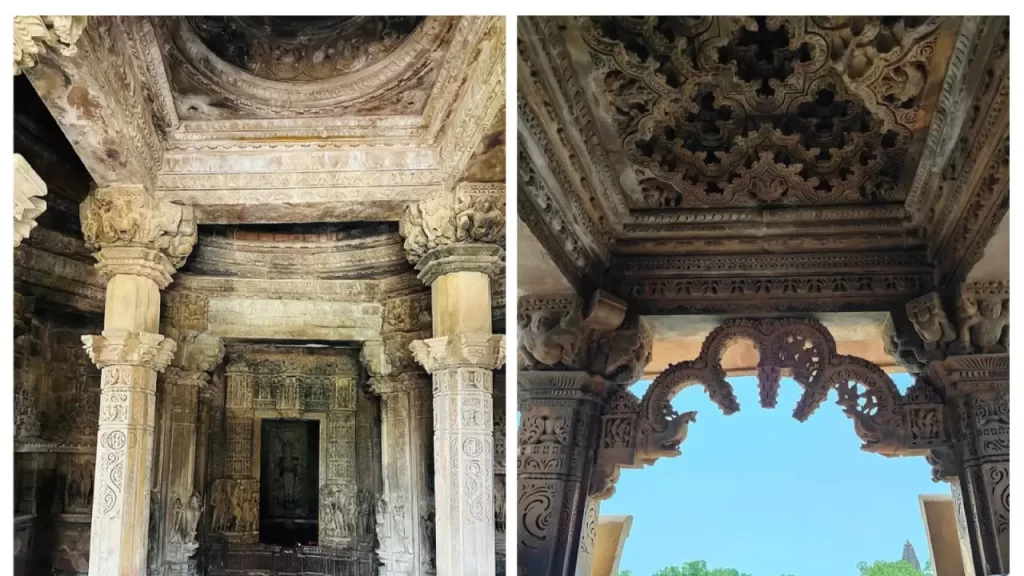
Ancient Stories: The Legend of the Temple
Now, each of the grand sites has a lovely tale, a legend that hangs around it like a zephyr. While the Kandariya Mahadeva Temple Khajuraho is renowned for its art, the particular legends directly associated with its building are more concerned with the devotion of the Chandela dynasty than a mythical story of gods descending to construct it. But the essence of the legends of Shiva, to whom the temple is sacred, underlies every stone.
Lord Shiva is also referred to as the Mahadeva, the Great God. He is considered to be the destroyer of evil and the transformer. He resides in the white snow-covered mountains of Kailash, accompanied by his devoted wife Parvati and his two sons Ganesha and Kartikeya. The Chandela kings who constructed the Kandariya Mahadeva Temple Khajuraho were devoted followers of Lord Shiva. They thought that by constructing such a huge temple, they were expressing their great respect and love for him.
You know, in our ancient Hindu scriptures, the Puranas, you find innumerable tales of devotion and the strength of faith. Although I do not know of a particular verse that specifically mentions the construction of the Kandariya Mahadeva Temple Khajuraho, the Skanda Purana, for instance, frequently discusses the virtues of constructing temples and showering devotion upon deities. It states, and I’ll paraphrase it for you, “One who builds a temple for the Lord earns great merit and resides in the divine abode.”
This faith, this profound knowledge of the divine reward for such deeds, was certainly a motivating factor in the construction of the Kandariya Mahadeva Temple Khajuraho. Imagine, the kings thought that by constructing this temple, they were not only building a stone structure, but a bridge to the divine.
Read More>> Bhojshala Temple

Why This Place is Special: Significance of the Temple
My child, the Kandariya Mahadeva Temple Khajuraho is not only a traveler attraction; it’s a site of great spiritual importance. It’s a reminder of a period when human beings conveyed their deepest emotions for the divine through art.
A Symbol of Devotion: Above all, it’s a magnificent testament to Lord Shiva. Every pillar, every spire, every carving is directed towards the sky, proclaiming in silence the piety of the Chandela rulers.
A Lesson in Dharma: The carvings on the walls of the temple, while occasionally a bit too mature for your sight, are not only about aesthetics. They symbolize various aspects of life, such as dharma (righteous living), artha (wealth), kama (pleasure), and moksha (salvation). These are the four human goals in Hinduism. The temple is a grand method of instruction that all parts of life, even the worldly desires, can be harmonized with spiritual aspiration. It is like a huge textbook sculptured in stone!
Architectural Masterpiece: The Kandariya Mahadeva Temple Khajuraho stands as an archaeological masterpiece. It reflects the kind of geniuses that the engineers and artists of those days were. They did not have massive machines like we have now, but they constructed a thing that has lasted for a thousand years! That is a reflection of human creativity and artistic genius.
Conservation of Culture: These temples, such as the Kandariya Mahadeva Temple Khajuraho, have kept intact a view of the culture, religion, and art forms of a past era. They are a time capsule, giving us an idea of how people lived, what they believed in, and how they used to express themselves through art.
Read More>> Mahalakshmi Temple Kolhapur | Ambabai Temple
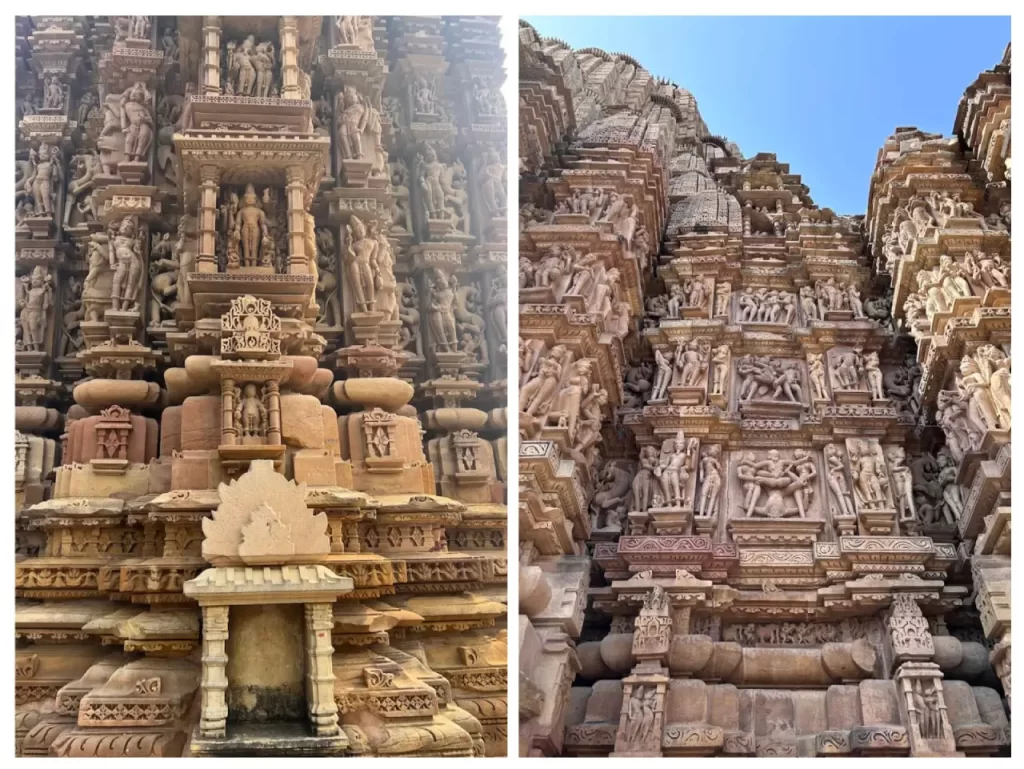
The Art of Stone: Kandariya Mahadeva Temple Architecture Style
Let’s discuss how the Kandariya Mahadeva Temple Khajuraho was constructed. Picture a huge LEGO set, but composed of enormous stones and sculpted by master craftsmen!
The temple is built on a highly elevated platform, a mountain-like one, so that it appears even more glorious. When you go around it, you can see hundreds, maybe thousands, of carvings. They’re not random; they narrate stories. They depict gods and goddesses such as Shiva, Vishnu, Brahma, and many others. They depict celestial entities, dancers, musicians, and even snapshots from normal life.
The Kandariya Mahadeva Temple Khajuraho is constructed in what is known as Nagara style, a characteristic of temples in North India. It has a high, curving tower referred to as a shikhara, which resembles a mountain peak stretching to the sky. The shikhara in this temple is one of the highest at Khajuraho, so the Kandariya Mahadeva Temple Khajuraho stands out. There are a number of smaller towers around the main tower, creating a beautiful clustered effect, almost like a mountain range itself.
Inside the temple, there are several halls:
Ardhamandapa: This is the entrance porch, where you first step in.
Mandapa: This is the main assembly hall, where people would gather for prayers and ceremonies.
Maha Mandapa: This is an even larger hall, often used for more elaborate rituals and dances.
Antarala: It is a small vestibule, a type of passage, that opens into the most sacred area of the temple.
Garbhagriha: It is the most sacred area of the temple, the “sanctum sanctorum,” where the principal idol of Lord Shiva (most often a lingam) is installed. It’s a tiny dark chamber, intended for quiet reflection and prayer.
The whole temple is adorned with intricate carvings, both externally and internally. The artists made use of a soft sandstone, through which they were able to carve in amazing detail. Take a good look, and you’ll be able to spot the small jewels, facial expressions, and even creases in their attire. It’s simply astonishing! The Kandariya Mahadeva Temple Khajuraho is a living museum of ancient Indian art.
Read More>> Shirdi Sai Baba Temple Maharashtra
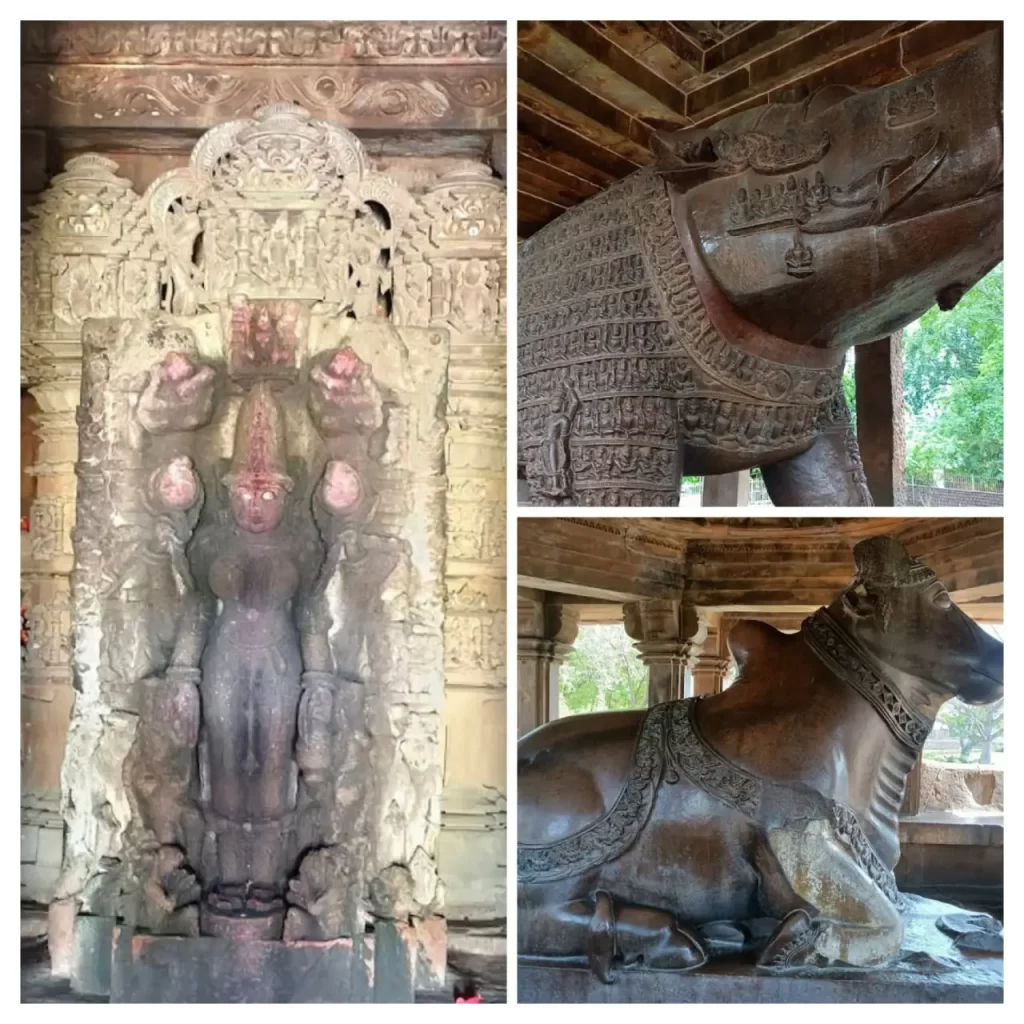
Tales and Beliefs: Myths and Beliefs
Let’s now discuss some of the interesting myths and beliefs about the Khajuraho temples, the Kandariya Mahadeva Temple Khajuraho being one of them. Although the most popular thing about Khajuraho is its erotic sculptures, it’s essential to know the underlying meaning behind those for young minds.
It is a question on everyone’s mind as to why there are such sculptures on a temple of a god. There are some speculations, and each one gives a different spin:
Celebration of Life: Another belief is that these sculptures symbolize the celebration of life in every form, both human desires and pleasures. In ancient India, these were not isolated from spirituality but as part of an entire human experience. The temple, thus, demonstrates how one can attain spiritual freedom (moksha) even with a taste of the pleasures of the world. It’s similar to saying life is a path, and there is a place for all of it.
Protection against Evil: Others think that these sculptures served as a form of magical protection for the temple. Just like gargoyles on European cathedrals were placed there to ward off evil spirits, these colorful and dynamic statues were believed to repel bad energy.
Tantric Practices: A theory holds that the sculptures are connected to Tantric practices, which were a component of certain Hindu and Buddhist practices. Tantra is all about the union of male and female energies (Shiva and Shakti) and constitutes a path toward spiritual enlightenment. The sculptures could be symbols for these cosmic unions.
Leaving Desires at the Door: A more philosophical interpretation is that such carvings were installed on the outer walls of the temple. The notion was that once a devotee stepped into the holy precinct of the Garbhagriha, he would leave all desires and distractions of the world behind and concentrate only on the divine within him. It’s similar to washing one’s hands before handling something sacred.
It should be kept in mind that these sculptures represent but a fraction of the total artwork of the Kandariya Mahadeva Temple Khajuraho. The vast majority of the carvings are of gods, goddesses, celestial entities, animals, and everyday life scenes, all symbolizing the rich cloth of Hindu mythology and culture. The Kandariya Mahadeva Temple Khajuraho is a reflection of the eclectic and tolerant nature of ancient Indian thought.
Read More>> Shani Shingnapur: Only Village Without House Doors
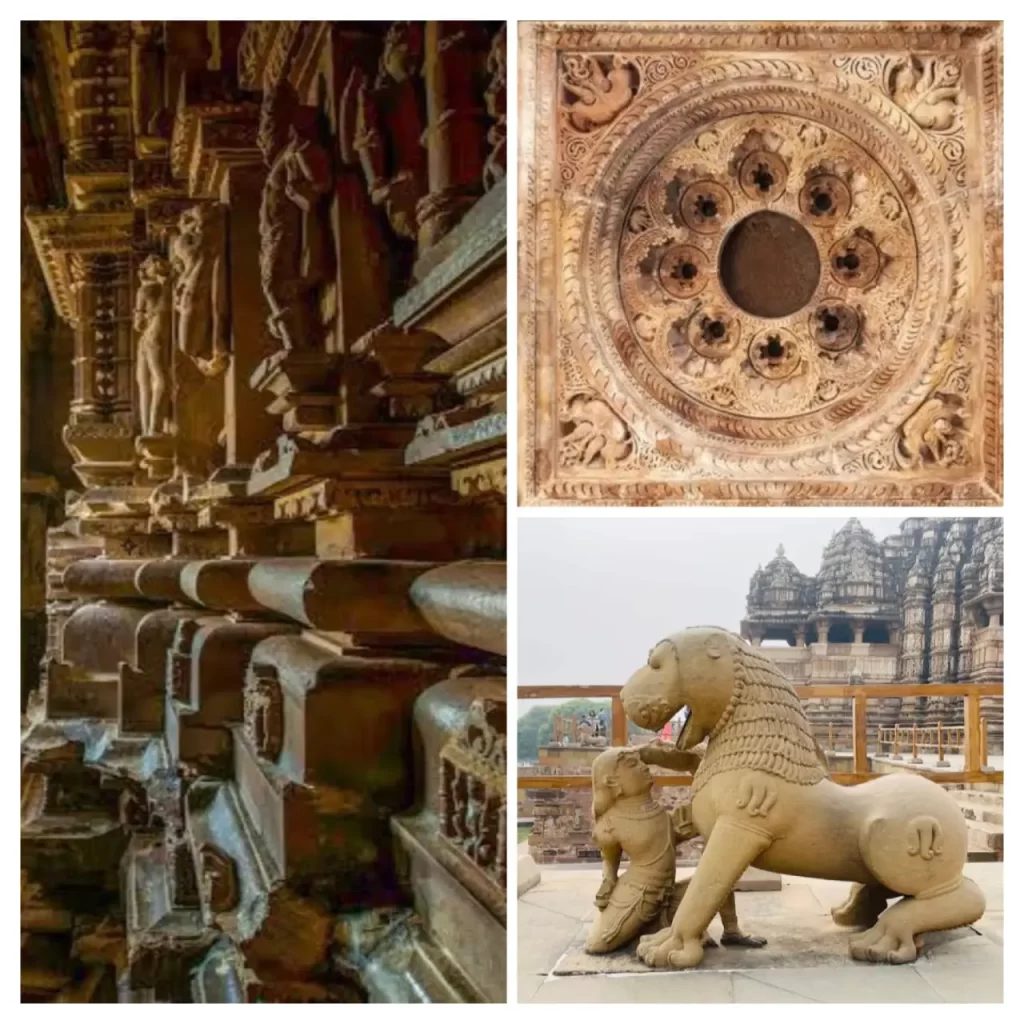
When to Visit: Kandariya Mahadeva Temple Timings
It’s always nice to know when to visit this beautiful location, the Kandariya Mahadeva Temple Khajuraho, if you ever do go there.
The Khajuraho temples, such as the Kandariya Mahadeva Temple Khajuraho, are usually open between 6:00 AM and 6:00 PM daily. Nevertheless, it is always safe to reconfirm these hours before you go, as they may change occasionally. The ideal time to visit would be during the cooler months of October to March, when the weather is good for sightseeing.
More to See: Hindu Places to Visit Near the Temple
It is not just the Kandariya Mahadeva Temple Khajuraho but a whole cluster of temples, each charmingly different. After witnessing the beauty of the magnificent Kandariya Mahadeva Temple Khajuraho, one can visit other stunning temples:
Lakshmana Temple: This one is another fantastic temple dedicated to Lord Vishnu. It is nearly as beautiful as the Kandariya Mahadeva Temple Khajuraho and has the same complexity in carvings.
Vishvanatha Temple: Dedicated to Lord Shiva, the temple is also a good representation of Chandela architecture.
Devi Jagadambi Temple: The temple, which was originally a Lord Vishnu temple, came to be dedicated to Goddess Jagadambi.
Chitragupta Temple: Dedicated to Surya, the sun god, this temple stands out for its representation of the sun god on a chariot.
Parsvanath Temple: Although most of the Khajuraho temples are Hindu, some are equally stunning Jain temples. The largest and most beautiful of these is the Parsvanath Temple.
These temples form the Western Group of temples, which are extremely close to one another. There are also the Eastern and Southern Groups of temples, which you can visit if you have more time at your disposal. Khajuraho is actually a treasure chest of art and spirituality of ancient India. The crown jewel is the Kandariya Mahadeva Temple Khajuraho, but the rest of the temples around it fill the frame.
Your Route There: How to Go to the Temple
And now, if you’re looking forward to seeing the Kandariya Mahadeva Temple Khajuraho and the other great temples, let me inform you how you can go there.
By Air: The most convenient means of reaching Khajuraho is through the air. There is an airport at Khajuraho (code: HJR), which is only a few kilometers from the temple complex. You can fly to Khajuraho from major Indian cities such as Delhi and Varanasi. From the airport, you can simply take a taxi or auto-rickshaw to the temples.
By Train: The closest railway station to Khajuraho is the Khajuraho Railway Station (code: KURJ), which is well linked with the major cities. An alternative is Satna Railway Station (code: STA), which is some 120 kilometers away and has better connectivity. From Satna, one can travel to Khajuraho either by taxi or bus.
By Road: Khajuraho is also well linked by road with surrounding towns and cities. You can travel by bus or hire a taxi from Chhatarpur, Satna, Jhansi, and Gwalior. The roads are relatively good, and the drive is very picturesque.
When you are actually in Khajuraho, the Kandariya Mahadeva Temple Khajuraho and all the rest of the temples in the Western Group are all within walking distance of one another. You may also rent cycles or auto-rickshaws for visiting the various temple groups.




